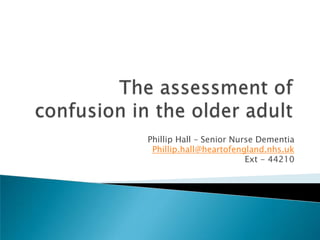
The assessment of confusion in the older adult
- 1. Phillip Hall – Senior Nurse Dementia Phillip.hall@heartofengland.nhs.uk Ext - 44210
- 2. a mental state characterized by disorientation regarding time, place, person, or situation. It causes bewilderment, perplexity, lack of orderly thought, and inability to choose or act decisively and perform the activities of daily living
- 3. Confusion in the acute hospital
- 4. Dementia – some causes treatable Delirium – usually treatable and often the first symptom of serious underlying condition Depression – often responds well to treatment All benefit from adaptations to care
- 5. The development of multiple cognitive deficits manifested by: A. Two or more of the following cognitive disturbances: (a) aphasia (language disturbance) (b) apraxia (impaired ability to carry out motor activities depite intact motor function) (c) agnosia (failure to recognize or identify objects despite intact sensory function) (d) disturbance in executive functioning (i.e., planning, organizing, sequencing, abstracting) (e) memory impairment (impaired ability to learn new information or to recall previously learned information) B. The cognitive deficits in criteria A each cause significant impairment in social or occupational functioning and represent a significant decline from a previous level of functioning. C. The course is characterized by gradual onset and continuing cognitive decline
- 6. Alzheimer’s Disease - 30% to 50% Vascular Dementia - 20% (but 50% of cases in hospital) Lewy Body Dementia – 10% to 30% Frontal Lobe Dementia – 5% Other causes - <5%
- 7. Attention Concentration Orientation Short term memory Long term memory Praxis Language Executive function
- 9. Delirium is a syndrome, or group of symptoms, caused by a disturbance in the normal functioning of the brain. The delirious patient has a reduced awareness of and responsiveness to the environment, which may be manifested as disorientation, incoherence, and memory disturbance. Delirium is often marked by hallucinations, delusions, and a dream-like state.
- 10. CONFUSION ASSESSMENT METHOD (CAM) SHORTENED VERSION WORKSHEET I. ACUTE ONSET AND FLUCTUATING COURSE BOX 1 a) Is there evidence of an acute change in mental status from the patient’s baseline? No ____ Yes___ b) Did the (abnormal) behaviour fluctuate during the day, that is tend to come and go or increase and decrease in severity? No ____ Yes___ II. INATTENTION Did the patient have difficulty focusing attention, for example, being easily distractible or having difficulty keeping track of what was being said? No ____ Yes___ ________________________________________________________________________ III. DISORGANIZED THINKING BOX 2 Was the patient ‘s thinking disorganized or incoherent, such as rambling or irrelevant conversation, unclear or illogical flow of ideas, or unpredictable switching from subject to subject? No ____ Yes____ IV. ALTERED LEVEL OF CONSCIOUSNESS Overall, how would you rate the patient’s level of consciousness? Alert (normal) or ___ Vigilant (hyperalert) ___ Lethargic (drowsy, easily aroused) ___ Stupor (difficult to arouse) ___ Coma (unarousable) Do any checks appear? (any level of consciousness other than ‘normal’) No ____ Yes ___ ________________________________________________________________________ If all ‘Yes’s’ in Box 1 are checked and at least one ‘Yes’ in Box 2 is checked a diagnosis of delirium is suggested.
- 11. Deteriorating cognitive function: reduced concentration, slow responses, confusion Perception: visual or auditory hallucinations Physical function: reduced mobility/ movement, restlessness, agitation, change in appetite, sleep disturbances Social behaviour: lack of co-operation, withdrawal, altered communication, mood Emotional disturbance: mood swings
- 12. Three types of delirium; Hyperactive: Agitated, calling out, restless, wandering Least common, most frequently diagnosed Increased risk of falls and injury Hypoactive: Lethargic, slow to answer questions Most common, most dangerous, least recognised Increased pressure ulcer risk and aspirational pneumonia Mixed: combination of the above
- 13. Increased morbidity Increased mortality Increased falls Higher length of stay Decreased likelihood of return home Eight fold increase of new diagnosis of dementia Longer the delirium remains untreated the greater all of the above risks
- 14. CHARACTERISTI CS DEMENTIA DELIRIUM DEPRESSION Onset Insidious, slow and often unrecognized Sudden, abrupt Recent, may correspond with life change Course over 24 hours Fairly stable, may see changes due to stresses Fluctuating, often with nighttime exacerbations Fairly stable, may be worse in the morning Consciousness Clear Reduced Clear Alertness Normal Increased, decreased or variable Normal Psychomotor activity Normal but may have apraxia Increased, decreased, mixed Variable, agitation or retardation Duration Months to years Hours to weeks Variable (at least 6 weeks) may be months to years Attention Generally normal Globally disordered, fluctuates Little impairment, very distractible Orientation Often impaired (answer may be close to right) Usually impaired, variable, fluctuates Usually normal, may answer “don’t know” Speech Difficulty word finding, preseveration Often incoherent, slow or rapid May be slow
- 15. Right place, right time, right approach History is essential (recent and longer term) Confusion isn’t restricted to a single cause, at least 5 out of 6 patients with delirium will already have dementia Communication difficulties will need serious consideration Be aware of impact of identifying a problem Refer (RAID)
- 16. Alzheimer’s Society – http://www.alzheimers.org.uk/site/scripts/documents.php?categoryID=200 293 Other cognitive assessments; Addenbrooke’s Cognitive Assessment - http://www.stvincents.ie/dynamic/File/Addenbrookes_A_SVUH_MedEl_tool.p df 6 Item Cognitive Test – http://www.patient.co.uk/doctor/six-item-cognitive-impairment-test-6cit MMSE – http://www.guysandstthomas.nhs.uk/resources/our-services/acute- medicine-gi-surgery/elderly-care/mini-mental-state-evaluation.pdf
- 17. Confusion Assessment Method training manual - http://www.viha.ca/NR/rdonlyres/0AC07A64-FF24-41E3-BDC5- 41CFE4E44F33/0/cam_training_pkg.pdf European Delirium association – http://www.europeandeliriumassociation.com/
- 18. Differential diagnosis – dementia and depression; http://www.cmglinks.com/cmg/lectures_dementia/part1/006.htm Depression in older adults (RCP); http://www.rcpsych.ac.uk/mentalhealthinformation/mentalhealthproblems/depression/depressioninol deradults.aspx Depression rating scales; Geriatric Depression Scale – http://www.chcr.brown.edu/GDS_SHORT_FORM.PDF Cornell Scale For Depression In Dementia – http://geropsychiatriceducation.vch.ca/docs/edu-downloads/depression/cornell_scale_depression.pdf
